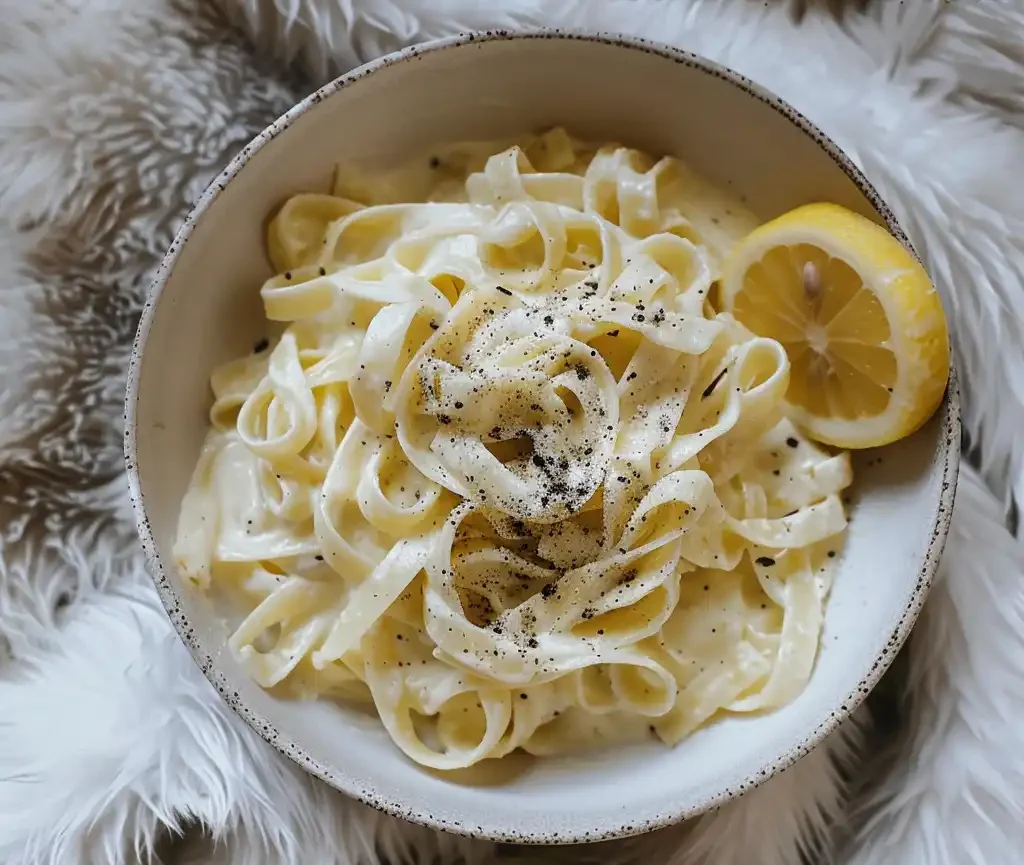The first time I made this lemon-butter tagliatelle was during a particularly dreary February weekend. I was longing for something that tasted like sunshine, something that would brighten our table during those short winter days. I remember standing in my kitchen, zesting lemons near the window, watching the citrus oils release into tiny fragrant clouds, and thinking how something so simple could transform an ordinary evening into something special.
After several iterations (and many willing taste-testers around my dining table), this pasta has become one of my most requested recipes. There’s something magical about the way the bright lemon cuts through the richness of the butter and cream, creating a sauce that’s both indulgent and refreshing at the same time.
The Beauty of Simplicity
What I love most about this dish is how it elevates just a handful of ingredients into something that feels special enough for company but simple enough for a Wednesday night. The sauce develops a silky richness that clings beautifully to the wide ribbons of tagliatelle, creating the perfect bite every time.
I’ve made this countless times in my kitchen, tweaking the amount of lemon, adjusting the reduction time, and experimenting with different pasta shapes. While I’ve tried it with everything from spaghetti to shells, I always come back to tagliatelle or fettuccine – there’s something about the way those wide noodles cradle the sauce that makes every bite perfectly balanced.
What You’ll Need
Pasta: Tagliatelle or linguine/fettuccine; the flat, wide shape creates the perfect surface for the silky sauce to cling to, though I’ve made this with whatever shape was hiding in my pantry in a pinch
Butter: Salted butter; I find it adds just the right seasoning base, though unsalted works if you prefer to control the salt level entirely yourself
Garlic: Either powder or fresh minced cloves; both bring different dimensions to the dish – powder for a gentle background note, fresh for a more pronounced flavor
White wine: A dry variety like Chardonnay; it adds incredible depth and acidity that transforms the sauce (and gives me an excuse to pour a glass for the chef)
Heavy cream: The real deal creates that luxurious texture; I’ve tried substituting lighter options in countless test batches, but nothing compares to how heavy cream coats the pasta
Lemon juice: Freshly squeezed from a large lemon; the brightness cuts through the richness and brings everything to life
Salt & pepper: For seasoning to taste
Optional Parmesan: For that final touch of savory richness and visual appeal
Let’s Get Cooking
Begin with the Pasta
Cook your tagliatelle according to the package instructions, keeping in mind that we’ll finish it in the sauce. I’ve learned through many pasta nights that salting the water generously makes all the difference – it should taste like the sea. This proper foundation means you’ll need less salt later in the sauce.
Create the Sauce Base
While your pasta bubbles away, melt the butter in a skillet over low-medium heat. This is where the magic begins. Add the garlic and whisk it in, allowing the aroma to bloom but being careful not to let it brown. I love watching this simple beginning transform into something extraordinary.
Add Depth with Wine
Pour in the white wine and increase the heat slightly until you see gentle bubbles forming. Let it simmer for 2-3 minutes, allowing the alcohol to cook off while leaving behind that wonderful depth of flavor. There’s something mesmerizing about watching the sauce reduce, knowing that each bubble concentrates the flavor even more.
Bring in the Richness
Now for the luxurious part – add the heavy cream gradually, about half a cup at a time, whisking between additions. This is also when I add the lemon juice, watching as it slightly thickens the sauce. Sometimes, if I’m looking for a thicker consistency, I’ll whisk in a bit of freshly grated Parmesan – a trick I discovered during one of my many test batches.
Season with Care
This is where you make the dish your own. Add the garlic powder if you’re using it, along with salt and pepper to taste. Remember that if you’ve salted your pasta water well, you’ll need less salt in the sauce.
The Final Symphony
Keep whisking intermittently as the sauce simmers for 8-10 minutes. You’ll see it gradually transform into a velvety consistency similar to an alfredo sauce, but with that distinctive bright note from the lemon.
Marry the Pasta and Sauce
Here’s a restaurant trick I swear by: transfer the pasta directly from its cooking water into the sauce. Those little droplets of starchy water that come along for the ride are culinary gold. I also add 2-3 tablespoons of the hot pasta water intentionally – it contains salt and starch that emulsify with the fats in the sauce, creating that silky texture that makes you want to lick the plate.
Gently toss everything together, watching as the pasta absorbs some of the sauce and becomes glossy and perfect.
Make It Your Own
Over the years, I’ve played with this recipe countless times, adapting it to different seasons and cravings:
In spring, I often add fresh peas and a handful of tender herbs like mint and chives – they pop against the creamy backdrop and add a wonderful freshness.
For a more substantial dinner, especially when my brother visits (he’s always hungry), I’ve added sautéed shrimp or pieces of rotisserie chicken, letting them warm through in the sauce before adding the pasta.
When I want something truly indulgent, I finish the dish with a sprinkle of toasted pine nuts and an extra drizzle of my best olive oil – something I started doing after a memorable trip to Italy where I saw a chef finish nearly every pasta dish this way.
My Best Tips
Don’t rush the sauce reduction – those 8-10 minutes of gentle simmering are when the magic happens. I’ve tried shortcuts, but patience truly rewards here.
Reserve more pasta water than you think you’ll need. After making this dozens of times, I’ve learned that having extra on hand allows you to adjust the consistency if the sauce tightens up too much as it sits.
When zesting and juicing your lemon, do it over the sauce to catch every drop of the aromatic oils. This tiny detail makes a noticeable difference in the final flavor – something I discovered by accident when my zester slipped during an early test batch.
Temperature matters – I serve this immediately in warmed bowls. The sauce continues to thicken as it cools, and that first twirl of pasta should be absolutely perfect.
Frequently Asked Questions
Can I make this ahead of time? → This sauce is really best freshly made, but if needed, you can prepare it up to the cream stage and then finish with the pasta just before serving. I’ve found reheating can cause the sauce to break.
What if I don’t use alcohol in cooking? → You can skip the wine entirely and use chicken broth with a splash of white wine vinegar or additional lemon juice for acidity.
Will light cream work instead of heavy cream? → After testing both, I can say that heavy cream creates a more stable sauce. Light cream may separate more easily, especially with the acid from the lemon.
How do I store leftovers? → Store in an airtight container in the refrigerator for up to 2 days. Reheat gently on the stove with a splash of cream or pasta water to bring the sauce back together.
Can I add vegetables to make it a complete meal? → Absolutely! Sautéed asparagus, peas, or spinach fold in beautifully. I often make a version with roasted cherry tomatoes that burst with sweetness against the tangy sauce.
Print
Lemon-Butter Tagliatelle
- Total Time: 25 minutes
- Yield: 2 servings 1x
- Diet: Vegetarian
Description
A creamy, silky pasta dish featuring the bright acidity of lemon balanced with rich butter and cream. This elegant yet simple recipe creates restaurant-quality tagliatelle in minutes, perfect for weeknight dinners or special occasions.
Ingredients
- 1/2 lb tagliatelle, linguine, or fettuccine pasta
- 4 tbsp salted butter
- 1/2 tsp garlic powder or 1–2 minced garlic cloves
- 1/4 cup dry white wine (chardonnay recommended)
- 1 cup heavy cream
- Juice from 1 large lemon
- Salt and freshly ground black pepper, to taste
- Freshly grated Parmesan cheese for serving (optional)
Instructions
- Cook the Pasta: Bring a large pot of heavily salted water to a boil. Add the tagliatelle and cook according to package instructions until al dente. Properly salting the pasta water creates a flavorful foundation for the entire dish and reduces the need for additional salt later.
- Prepare the Base: While the pasta cooks, melt the butter in a large skillet over low-medium heat. Add the garlic (either powder or minced) and whisk to combine, allowing the garlic to become fragrant without browning, about 30 seconds.
- Add Wine: Pour in the white wine and increase the heat slightly until the mixture begins to bubble. Let it simmer for 2-3 minutes to cook off the alcohol while concentrating the flavors. The wine adds a complex depth of flavor to the final sauce.
- Create the Cream Sauce: Add the heavy cream in two additions (1/2 cup at a time), whisking between each pour. Add the fresh lemon juice and continue whisking. The sauce should begin to thicken as it bubbles. If it remains too thin, consider adding some freshly grated Parmesan cheese to help thicken it.
- Season the Sauce: Add salt and pepper to taste. Remember that the pasta water and salted butter already contain salt, so adjust accordingly. The pepper adds a subtle heat that complements the lemony brightness.
- Reduce and Thicken: Continue to whisk occasionally while simmering the sauce for 8-10 minutes until it reaches a consistency similar to alfredo sauce. The sauce should coat the back of a spoon but still flow smoothly.
- Combine Pasta and Sauce: Using tongs, transfer the cooked pasta directly from the boiling water into the sauce without draining. Add 2-3 tablespoons of the starchy pasta cooking water to the sauce and gently toss everything together. The starchy water helps the sauce cling to the pasta while adding a silky texture.
- Serve: Plate immediately and top with freshly grated Parmesan cheese and additional freshly ground black pepper if desired.
Notes
- For best results, use freshly squeezed lemon juice rather than bottled juice.
- If you can’t use alcohol, substitute the white wine with chicken broth or vegetable stock with a splash of white wine vinegar for acidity.
- The dish comes together quickly, so have all ingredients measured and ready before starting.
- Fresh tagliatelle will cook much faster than dried pasta, usually in 2-3 minutes.
- For a brighter flavor, add some lemon zest along with the juice.
- This sauce is delicate and is best eaten immediately; it doesn’t reheat well.
- Prep Time: 10 minutes
- Cook Time: 15 minutes
- Category: Main-course
- Method: Stovetop
- Cuisine: Italian
Nutrition
- Serving Size: 1/2 of recipe
- Calories: 850
- Sugar: 4g
- Sodium: 340mg
- Fat: 63g
- Saturated Fat: 39g
- Unsaturated Fat: 18g
- Trans Fat: 0g
- Carbohydrates: 54g
- Fiber: 2g
- Protein: 12g
- Cholesterol: 210mg


